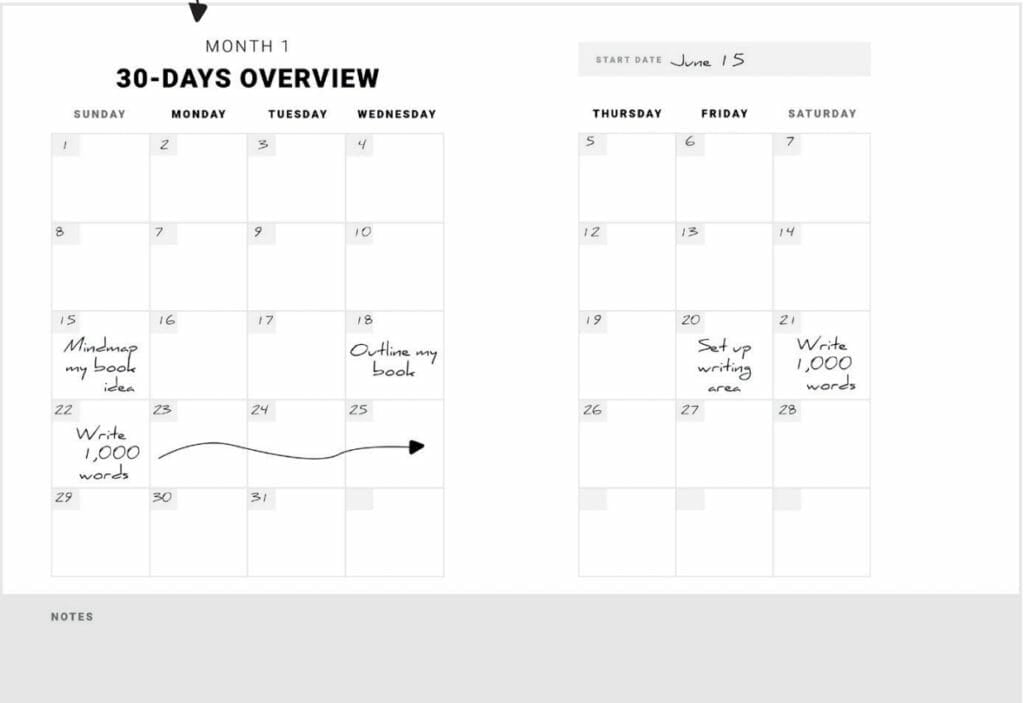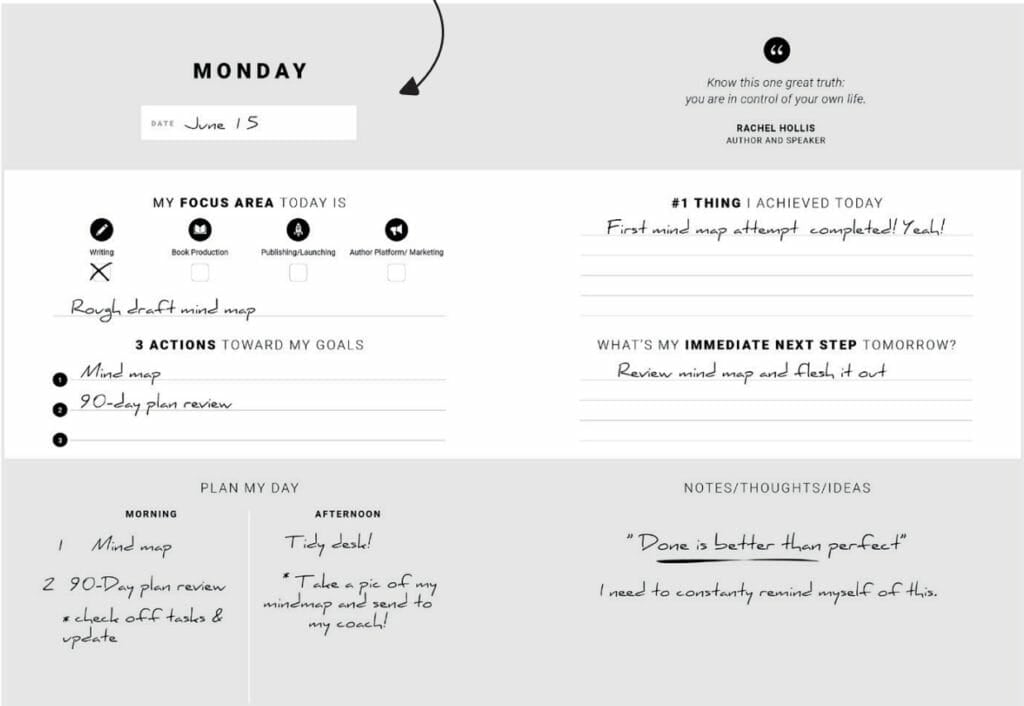Internally, you’re screaming.
You’ve just had another failed attempt to get more of your book written.
This time, it was your mom calling to check up on you and see when you’re coming to visit next.
Ignoring her call wouldn’t have helped. She’d just keep ringing until you answered.
And once you’ve spoken to your mom… well, let’s just say that the vibe for writing just ain’t there.
You’re questioning whether the Universe even wants you to finish this book!
Related: How to Write A Book
But you know it’s important. Not just for you, but for the people you’re looking to serve. You want to help. You want to change lives. But you can’t do that if you don’t get this book DONE.
If only you had access to a tool that allowed you to stay focused and ditch the overwhelm.
Enter the Author Success Journal.
While it won’t stop random phone calls from your mother happening, it will allow you to get focused and clear on your goals and move you forward in your journey to become an author.
You just need to know what to focus on, when to pivot, and when to batten down the hatches and get it done.
Ready to be a successful published author?
Let’s get started.
The 90-Day Author Journal
Created by Self-Publishing School, the Author Success Journal is a 90-day system that helps you stay focused on the goals that matter… anything related to writing, publishing, or launching your book.
You get visibility on your most important goals and actions steps daily, and you are asked to reflect and adjust along the way.
Why 90 days?
A quarter feels like a lot of time, but it’s also not a lot of time that makes you feel like you’ll never be finished. It’s about short-term wins. Actionable, achievable steps to help you stay focused and get work done.
And if you need to pivot, 90 days is a short amount of time to make you feel like you haven’t lost too much time or effort.
BUT: your success as an author depends on the daily actions you take.
Using the Author Success Journal will bring focus to your writing goals and allow you to move forward (rather than stand still) in your author journey.
Let’s break down the entire 90 day Author Success Journal process so you can see how it helps you write and publish your book.
Step #1: Mind Map Your Way to Clarity
When you start writing your book (or maybe you’re just starting), the first thing you’ll do is mind map your idea. This is so you can figure out the direction your writing will take.
This is replicated in the Author Success Journal…
The mind mapping process isn’t just for your book.
Personally, I’m a huge fan of mind mapping. I don’t know about you, but it can get pretty loud and messy in my mind.
Mind mapping allows me to get everything that’s swirling around in my head onto paper so I can visually see things and make decisions. Of course, you can use digital mind mapping tools, but I prefer colored pens and big pieces of paper.
If I’m stuck, the first thing I’ll do is mind map.
Inside the journal, the very first thing you’re encouraged to do is do a brain dump. You can do this in the form of a mind map or you can simply jot down whatever you’re thinking about.
Before you can get clear on your goals, you need to get everything out of your head.

Once the swirling mess is out of your head and in your journal, you’re ready for the next step.
Setting S.M.A.R.T goals.
Step #2: Set S.M.A.R.T Goals
In my experience, one of the biggest issues when it comes to getting anything done is lack of clarity around next steps.
If you’re anything like me, you’ve got a million ideas for books, courses, and programs at any given time.
How are you meant to keep everything straight so you can complete just one thing at a time?
And it’s not that you haven’t set goals. Of course you’ve done that!
But have you set S.M.A.R.T goals?
If you haven’t heard of this before, here’s what this acronym stands for:
S.M.A.R.T stands for: Specific, Measurable, Actionable, Relevant, Time-Bound.
An example of a S.M.A.R.T. goal for your book might be: Complete second draft edits by Friday.
By setting S.M.A.R.T goals, you create a clear plan of what you’re trying to achieve and how to track it.
The key to reducing overwhelm as you’re working on your author journey, is to keep your goals small. Remember, we’re looking to complete these goals within the next 90 days.
You’ve got space in your Author Success Journal to record your S.M.A.R.T goals.
If you want to set yourself up for success, write those S.M.A.R.T. goals on a piece of paper and keep it close to your computer. This is so you see them every day.
Avoid choosing goals that make you start thinking that you can’t achieve them, that they’re impossible, or that make you feel imposter syndrome. Choose goals that feel doable but stretch you.
You can do more than you think.
The next step is setting your 90 Day Goals.
Step #3: Create A 90-Day Plan
This next step is about taking your S.M.A.R.T goals and deciding on what you want to achieve within the next 12 months (like publish and launch your book!).
You’ll then break those down into 90 day goals, 60 day, and 30 day goals.
For each goal, you’ll have a date or deadline written. Remember, S.M.A.R.T goals are the aim here.
If you need to keep track of these digitally, go ahead and add those dates to your schedule. Set yourself a reminder each week to check your progress… or better yet, use the journal to track and map out where you’re at and adjust as needed.
Now that you’ve got your 90-day goals, let’s figure out what that looks like at a monthly level.
30-Day Plan & Overview
This is about taking those main 90-day S.M.A.R.T. goals and breaking them down into all the steps that allow you to achieve your end goal(s).
This is where you’ll break down your goals into the actionable steps needed to achieve them. Be intentional. Be realistic. Be CLEAR.
This is where a lot of brand new authors fail.
And it’s where overwhelm can set in. When you realize all the steps you’ve got to take, it can feel like there’s no end in sight.
But not you! No. You’re not going to allow overwhelm to stop you from moving forward.
What would that look like?
Let’s take the example from above. Complete second draft by Friday.
The 90-Day goal for that would be to have a rough draft completed in 30 days prior to starting the second draft.
Our 30 day plan might look something like this:

This 30 day view also allows you to see what other things might impact you achieving those goals. Write down anything you know is already in your schedule that might take you away from your author goals.
It’s about being schedule aware. It’s about being proactive with your time for writing and problem-solving BEFORE overwhelm hits.
The next step is to be crystal clear on what you’re focusing on. It’s time to list out your action steps.
Step #4: List Your Top Goals & Action Steps
This is all about outlining your top 3-5 goals for the next 30 days (if you have that many, you might only have two if you’re in the writing and editing phase).
Related: How To Outline A Book
It’s about setting your intentions and making a plan to achieve them.
Record your goals and then record the action steps you plan to take in the next 30 days to get you there.
Remember, you want to write specific, time-driven tasks based on what you’re trying to achieve over the next 30, 60 and 90 days.
At this point, you should be feeling ready to hit the ground running. The swirling mess inside your head should be more ordered.
Before we dive into the weekly and daily pages. Let’s reflect.
Step #5: Reflect on The Week Ahead
You might be thinking, Why do I need to reflect? I haven’t even started using the journal!
Because it’s about bringing clarity and awareness to where you’re at and what you’re trying to achieve.
You want to set yourself up for success.
You’ll see two pages that will ask you to write down what the week ahead looks like at a high level… What meetings do you have planned? Any work trips that will take you away? Social outings? School committments?
This is the area to record all of that information.
You’ll also find space to reflect on the previous week. I love looking back and seeing what worked and what didn’t.
The final question is about doing a gut-check on the week ahead of you. How are you feeling? Anything coming up that you need to address now?
Now’s the time to bring all of these things to light. This is not the time to shy away from things you’re scared of. Write them down… then figure out what you need to do to minimize their impact.
Doing all of this allows you to do a mini brain dump. It frees your mind from having to remember #allthethings and allows you to get laser focused when you are working on your book.
As you start each week, you’ll have the opportunity to repeat this process.
This is so you always have clarity and awareness of what’s going on around you and how you can ensure you meet your author goals.
Now we’re ready to dive into using the journal.
Step #6: Get Daily Focus
This is where overwhelm leaves the building and clarity enters.
The daily pages will help you get clear on what you’re doing and provide insight into what you might want to STOP doing…
In the example below, the day is spread across two pages.
Your first step is to choose your area of focus. This is to allow you to set the intention for how you want your day to play out.
The next step is to list your three main action steps you’ll take towards ACHIEVING your goals.
These are your most important items and must get done that day.
Then you plan out the rest of your day as you see fit.
At the end of the day, you’ll reflect. I like to do this part of the process as part of my evening routine.
You’ll also set yourself up for success by stating your IMMEDIATE next step for the next day.
This layout will bring clarity, focus and intention to your author goals.

Remember the overwhelm you were feeling at the beginning? I bet you’re not feeling that anymore.
By using the Author Success Journal, you can’t help but succeed, IF you use it every day.
By writing down what you’re focusing on each day and mapping out your action steps, how can you not achieve your book goals?
The other key components of the Author Success Journal include:
- Rewrite Top Goals & Action Steps. At the beginning of each new week, you’ll write down your top goals and action steps. This is to bring visibility to what you’re working on.
- Monthly Reflections. This is where you’ll review the previous month and track your progress on your 90-day and 30-day goals. If you need to pivot, this will make it obvious where you need to make changes.
- 90-Day Review. Once you finish your first Author Success Journal, you’ll have the opportunity to reflect and review the last 90 days. This will provide you with clarity on what worked well and what didn’t. You’ll be able to see patterns, figure out where you need to make changes, and also see where you succeeded!
The success you experience is dependent on the action steps you take.
By using the Author Success Journal, you bring visibility and awareness to your goals.
You can track and measure your progress. You can make decisions faster because you know where you’re at and where you’re heading.
I don’t need to tell you that what isn’t tracked, doesn’t get measured, right?!
Your Next Steps
If you’re here, it means you’re ready to take the leap and finally get the clarity and direction you need to finish writing and publishing your book.
We can even help you achieve this with the help of the Author Success Journal. Grab your copy today, or make another author’s day since it makes the perfect gift for writers.

